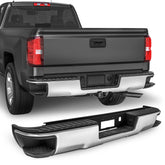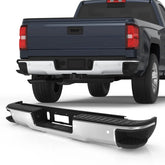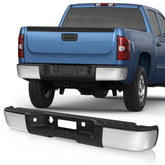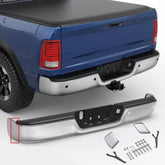What is rear bumper?
Now, please check your truck's rear bumper for damage. If it is damaged, it may be due to an accident in a parking lot or an accidental collision caused by a shopping cart that lost control. Don't worry, this is normal. It means that your rear bumper is doing its job well to protect the rear of the car. You can repair it or replace it and it will work again. If you are new to rear bumpers, take five minutes to read this article. We will take a deep look at what a rear bumper is, its basic parts, and its types.
What is a rear bumper?
"Rear bumper" is explained enough in the dictionary. It refers to the guardrail at the rear of the vehicle, which is used to protect the vehicle when it hits something. Protection is its most important function. The rear bumper is one of the exterior accessories of the vehicle. It can absorb the impact of minor collisions, minimize the impact of rear-end collisions, protect your vehicles, and let you drive more freely on the road, pasture, or forest.
In addition to the protection function, a high-quality rear bumper can also upgrade the appearance of your entire vehicle. A sturdy rear bumper sets off the rugged body lines, making your truck, Jeep or SUV look more refined and elegant, adding a unique shape to it.
What parts does the rear bumper consist of?
The rear bumper is both practical and aesthetic, providing a personalized look to your vehicle while protecting it from damage at the rear. It consists of multiple parts, each with a unique purpose.
Cover
The rear bumper cover is the outer shell of the rear bumper and we can see most directly. It is the most important component and is made of plastic or fiberglass. The rear bumper cover is the first line of defense for the bumper, absorbing small scratches, bumps, and dents caused by low-speed impacts. In addition, it hides the bumper structural components and provides a smooth and stylish appearance to enhance the overall beauty of the car. It is available in a variety of styles such as paint and chrome.
Reinforcement
The rear bumper reinforcement is located under the bumper cover and is made of strong metal materials such as aluminum or steel. It absorbs and disperses the impact force during a collision. The extra strength and solid structure prevent the full force of the collision from reaching key parts of the vehicle such as the trunk, fuel tank, or frame, ensuring that they are damaged to the minimum. It is also part of the vehicle frame structure, firmly connecting the bumper to the car frame, maintaining the structural integrity of the rear end, and preventing the vehicle from excessive collapse in an accident.
Energy absorber
The energy absorber is between the bumper cover and the reinforcement. It is made of foam or plastic honeycomb, and it cushions the impact of a collision. When a vehicle encounters a low- to medium-speed collision, the absorber compresses and absorbs some of the collision energy, allowing it to reach the solid reinforcement instead of directly entering the car frame. It protects the vehicle's bumper and frame.

Brackets
Brackets are small structural parts that fix and connect the cover, absorber, and reinforcement. They are usually made of metal or plastic. They can firmly fix the bumper components to the car frame, ensure the stability of the bumper, and prevent it from loosening or shifting, especially when driving at high speeds.
Sensors
Sensors are not equipped on all rear bumpers. However, most modern bumpers have integrated sensors, which use ultrasound or radar to measure the distance between the vehicle and the object behind it, help with parking, and collision detection, and some advanced vehicles also have automatic braking systems to prevent collisions when reversing.
Step pad
The step pad is a textured pad on top of the bumper used to stand or step onto to enter the cargo area. Its textured surface increases grip and prevents slipping when stepping onto the rear bumper, especially in wet or muddy conditions. It also protects the bumper from scratches, scuffs, and other damage from daily foot traffic, towing objects, or loading and unloading cargo.
3 Types of Rear Bumpers
Now that we know the components of a rear bumper, here are the three most common types of rear bumpers on the market:
Standard rear bumper
A standard bumper is the most common and simplest type. It is usually made of plastic, fiberglass, or metal such as aluminum, and is less likely to rust. It is cheaper to repair and replace because it is designed specifically for your vehicle and fits your model perfectly. It is mainly used for collision protection and aesthetics, giving the vehicle's rear a stylish look. Standard bumpers can also integrate parking sensors or camera systems for added safety features.

Tube rear bumper
Tube rear bumpers are made of steel tubes or aluminum. They consist of large round or square tubes that form a frame at the rear of the vehicle, giving it a simple, sturdy look. It is lighter than a regular bumper, reducing the overall weight of the vehicle. Most people are fascinated by its rugged and sporty style.

Step rear bumper
The step bumper is commonly found on trucks and large SUVs. It does double duty, not only does it protect the vehicle, but its built-in steps make it easier to access the vehicle's cabin and get tools and equipment inside. It can also be fitted with a hitch ball for truck towing. With a variety of finishes and styles, it is a favorite among most car owners.

5 Types Of Rear Bumper Damage
While rear bumpers are designed to withstand impacts, they can still get damaged. Here are 5 common types of rear bumper damage:
Scratches and Scuffs
Scratches occur when a bumper comes into contact with a sharp object or another vehicle, causing wear and tear on it. Scratches may seem small, but if left untreated they can detract from the appearance of the vehicle and, in some cases, lead to rust or further damage. Minor scratches can be repaired with a light polish. Deeper scratches may require touch-up paint.

Dents
A dent on the rear bumper is usually caused by a low-speed collision. It can make the vehicle look ugly and reduce the structural integrity of the bumper. If you have a dent on your bumper, seek help from a professional body shop. Their professional technology can restore your bumper to its original shape without damaging the paint. If the dent is too severe, you need to replace the entire bumper.

Cracks
If you hit something very sharp while reversing, your rear bumper will be easily punctured or torn, causing it to crack. Cracks weaken the entire bumper structure and reduce its efficiency in absorbing impacts. In many cases, a cracked bumper cannot be repaired and replaced. But if it is a small puncture, it can be repaired with fillers.

Paint damage
Some minor collisions or scratches can cause the paint on the rear bumper to peel or flake off. In addition, regular exposure to the elements, sun, rain, and snow can also cause the bumper paint to fade, peel, or chip. Paint damage can make a vehicle look older. Compared to dents, scratches, and cracks, it is not complicated to repair. You can pick a paint that matches the original color and reapply it to complete the repair.
Loose or Misaligned Bumpers
In some cases, collisions and even wear and tear can cause the bumper to become loose or misaligned. If you see the rear bumper is skewed and not aligned with the car body, it is misaligned. A bumper that is too loose will cause rattles and noises when driving. You need to realign or reinstall it and adjust or replace the brackets to secure it.
Conclusion
If your bumper is too damaged to be repaired, please replace it in time. At MOSTPLUS, we provide you with high-quality rear bumpers that can not only better protect your vehicle but also upgrade your vehicle's appearance. You only need to click to have a brand-new rear bumper.
Featured Products
- $299.99
$359.99- $299.99
- Unit price
- / per
- $289.99
$368.99- $289.99
- Unit price
- / per
- $294.99
- $294.99
- Unit price
- / per
- $279.99
- $279.99
- Unit price
- / per














